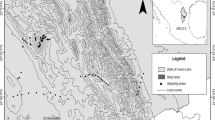Abstract
Species type in 42 samples was examined using ordination analysis to establish whether the vegetation pattern displays gradation due to environmental factors, and whether the pattern was being altered by human disturbance. The analysis displayed two patterns. First, the ordination on axis 1 demonstrated vegetation gradation from xeric communities on the plains to humid forests on the highland. This pattern is explained on the basis of moisture and nutrient variations. Vegetation vectors based on species presence-absence were correlated with average rainfall, carbon, nitrogen and zinc.
The second was separation of disturbed and undisturbed forest and bushland site categories on axis 2 of the ordination space. This pattern suggests that disturbance response is interactive with moisture so that only in moist communities does a significant vegetation response to disturbance occur.
Similar content being viewed by others
References
Belsky, A. J. 1987. Regeneration of natural and human-caused disturbances in the Serengeti National Park, Tanzania. Vegetatio 70: 51–60.
Boutton, T. W., Tiezen, L. L. & Imbamba, S. K. 1988. Biomass dynamics of grassland vegetation in Kenya, East Africa Afr. J. Ecol. 26: 89–101.
Chang, D. H. S. & Gauch, G. H.Jr. 1986. Multivariate analysis of plant communities and environmental factors in Ngari, Tibet. Ecol. 67: 1568–1575.
Digby, P. G. N. & Kempton, R. A. 1987. Multivariate Analysis of ecological Communities. Chapman and Hall, New York, USA.
Dublin, H. T. 1986. Decline of the Mara woodlands: The role of fire and elephants. Ph.D. Thesis, University of British Colombia.
Gauch, H. G.Jr. 1982. Multivariate Analysis in community Ecology. Cambridge studies in ecology. Cambridge University Press, Cambridge, UK.
Gower, J. C. 1966a. Some distance properties of latent root and vector methods used in Multivariate analysis. Biometrika 53: 325–338.
Gower, J. C. 1966b. A Q-techniques for the calculation of canonical variates. Biometrika 53: 588–589.
Greig-Smith, P. 1983. Quantitaive Plant Ecology, 3rd. ed. Butterworths, London, UK.
Griffiths, G. H. 1985. Mapping rangelands vegetation in northern Kenya from Landsat data. Ph.D Thesis, University of Aston, Birmingham, UK.
Jaetzold, R. & Schmidt, H. 1983. Farm management Handbook of Kenya Vol. 11. Ministry of Agriculture, Nairobi, Kenya.
Jensen, J. R. & Belsky, A. J. 1989. Grassland homogeneity in Tsavo National Park (West), Kenya. Afr. J. Ecol. 27: 35–44.
Karime, O. N. I. 1990. The changing Canduse patterns in the Ngorengore/Loita Plains. KREMU Techn. Report No. 135. Nairobi, Kenya.
Kershaw, K. A. & Looney, J. H. H. 1985. Quantitaive and Dynamic Plant Ecology, 3rd. ed. Edward Arnold.
Lamprey, R. H. 1984. Impact on Kenya savanna vegetation: A remote sensing approach. Ph.D Thesis Aston University, Birmingham, UK.
Msafiri, F. 1985. A vegetation map of Lolgorein area, Narok District. KREMU Technical Report No. 119, Nairobi, Kenya.
Mwichabe, S. 1986. Present Landuse of the Narok Area. Min. of Agric. NAL: Kenya Soil Survey misc. Report No. M31.
Norton-Grifiths, M., Herlocker, D. J. & Pennycuick, L. 1975. The patterns of rainfall in the Serengeti ecosystem. E. Afr. Wildl. J. 13: 347–374.
Odenyo, V. 1979. Application of Landsat data to the study of Land and Range Resource Management in the Narok area, Kenya. Canadian Centre for Remote Sensing.
Ogutu, Z.A. 1991. Human disturbances and vegetation dynamics in the Narok District, Kenya. Ph.D Thesis, Edinburgh University, UK.
Sinclair, A. R. E. 1979. The Serengeti environment. In: Sinclair, A. R. E. & Griffiths, M. (eds) SERENGETI Dynamics of an Ecosystem. University of Chicago Press, Chicago, USA.
Skarpe, C. 1990. Structure of the woody vegetation in disturbed and undisturbed arid savanna, Botswana. Vegetatio 87: 11–18.
Taiti, S. W. 1973. A vegetation survey of the Maasai Mara National Reserve, Narok District, Kenya. Msc Thesis. University of Nairobi, Kenya.
Author information
Authors and Affiliations
Rights and permissions
About this article
Cite this article
Ogutu, Z.A. Multivariate analysis of plant communities in the Narok district, Kenya: The influence of environmental factors and human disturbance. Vegetatio 126, 181–189 (1996). https://doi.org/10.1007/BF00045603
Received:
Accepted:
Issue Date:
DOI: https://doi.org/10.1007/BF00045603




